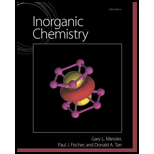
Concept explainers
a. Prepare a molecular orbital energy-level diagram for NO showing clearly how the atomic orbitals interact to form MOs.
b. How does your diagram illustrate the difference in electronegativity between N and O
c. Predict the bond order and the number of unpaired electrons.
d.
Trending nowThis is a popular solution!
Learn your wayIncludes step-by-step video

Chapter 5 Solutions
Inorganic Chemistry
Additional Science Textbook Solutions
Chemistry & Chemical Reactivity
Chemistry: Matter and Change
General, Organic, and Biological Chemistry (3rd Edition)
CHEMISTRY-TEXT
Chemistry
General Chemistry: Atoms First
- Consider the following molecular orbitals formed from the combination of two hydrogen 1s orbitals: a. Which is the bonding molecular orbital and which is the antibonding molecular orbital? Explain how you can tell by looking at their shapes. b. Which of the two molecular orbitals is lower in energy? Why is this true?arrow_forwardWhy are d orbitals sometimes used to form hybrid orbitals? Which period of elements does not used orbitals for hybridization? If necessary, which d orbitals (3d, 4d, 5d, or 6d) would sulfur use to form hybrid orbitals requiring d atomic orbitals? Answer the same question for arsenic and for iodine.arrow_forwardWhich of the following molecules or ions are para-magnetic? What is the highest occupied molecular orbital (HOMO) in each one? Assume the molecular orbital diagram in Figure 9.16 applies to all of them. (a) NO (b) OF (c) O22 (d) Ne2+arrow_forward
- The molecular orbital diagram of NO shown in Figure 10.47 also applies to the following species. Write the molecular orbital electron configuration of each, indicating the bond order and the number of unpaired electrons. (a) CN (b) CO (c) BeB (d) BC+ Figure 10.47 Molecular orbital diagram for nitric oxide (NO). The molecular orbital diagram for NO predicts a bond order of 2.5 and predicts that the molecule is paramagnetic with one unpaired electron. These predictions are verified by experimental measurements.arrow_forwardCalcium carbide, CaC2, contains the acetylide ion, C22. Sketch the molecular orbital energy level diagram for the ion and the electron dot strucure. (a) How many net and bonds does the ion have? (b) What is the carboncarbon bond order? (c) Compare the valence bond and MO pictures with regard to the number of and bonds and the bond order. (d) How has the bond order changed on adding electrons to C2 to obtain C22? (e) Is the C22 ion paramagnetic?arrow_forwardBoron trifluoride, BF3, reacts with ammonia, NH3, to form an addition compound, BF3NH3. Describe the geometries about the B and the N atoms in this compound. Describe the hybridization on these two atoms. Now describe the bonding between the B and N atoms, using valence bond theory. Compare the geometries and hybridization of these atoms in this addition compound with that in the reactant molecules BF3 and NH4.arrow_forward
- Consider the bonding in nitrate ion, NO3. First draw resonance formulas of this ion. Now describe the bonding of this ion in terms of molecular orbitals. (Refer to the delocalized bonding of the ozone molecule described in the text.) Suppose each atom uses sp2 hybrid orbitals. How many molecular orbitals can you form from the 2p orbitals that remain on these atoms? How many of these orbitals will be occupied?arrow_forwardWhat hybridization is required for central atoms that have a tetrahedral arrangement of electron pairs? A trigonal planar arrangement of electron pairs? A linear arrangement of e lectron pairs? How many unhybridized p atomic orbitals are present when a central atom exhibits tetrahedral geometry? Trigonal planar geometry? Linear geometry? What are the unhybridized p atomic orbitals used for? Describe the bonding in H2S, CH4, H2CO, and HCN, using the localized electron model.arrow_forwardBromine forms a number of oxides of varying stability. (a) One oxide has 90.90% Br and 9.10% O. Assuming its empirical and molecular formulas are the same, draw a Lewis structure of the molecule and specify the hybridization of the central atom (O). (b) Another oxide is unstable BrO. Assuming the molecular orbital diagram in Figure 9. 16 applies to BrO, write its electron configuration (where Br uses 45 and 4p orbitals). What is the highest occupied molecular orbital (HOMO) for the molecule?arrow_forward
- What modification to the molecular orbital model was made from the experimental evidence that B2 is paramagnetic?arrow_forwardThe sulfamate ion, H2NSO3, can be thought of as having been formed from the amide ion, NH2, and sulphur trioxide, SO3. (a) What are the electron-pair and molecular geometries or the amide ion and or SO3? What are the hybridizations of the N and S atoms, respectively? (b) Sketch a structure for the sulfamate ion, and estimate the bond angles. (c) What changes in hybridization do you expect for N and S in the course of the reaction NH2 + SO3 H2NSO3? (d) Is SO3 the donor of an electron pair or the acceptor of an electron pair in the reaction with amide ion? Does the electrostatic potential map shown below confirm your prediction?arrow_forwardCinnamaldehyde ocaus naturally in cinnamon oil. (a) What is the most polar bond in the molecule? (b) How many bonds and how many bonds are there? (c) Is cis-trans isomerism possible? If so, draw the isomers of the molecule. (d) Give the hybridization of the C atoms in the molecule. (e) What are the values of the bond angles 1, 2, and 3 ?arrow_forward
 Chemistry: Principles and PracticeChemistryISBN:9780534420123Author:Daniel L. Reger, Scott R. Goode, David W. Ball, Edward MercerPublisher:Cengage Learning
Chemistry: Principles and PracticeChemistryISBN:9780534420123Author:Daniel L. Reger, Scott R. Goode, David W. Ball, Edward MercerPublisher:Cengage Learning Chemistry: The Molecular ScienceChemistryISBN:9781285199047Author:John W. Moore, Conrad L. StanitskiPublisher:Cengage Learning
Chemistry: The Molecular ScienceChemistryISBN:9781285199047Author:John W. Moore, Conrad L. StanitskiPublisher:Cengage Learning Chemistry & Chemical ReactivityChemistryISBN:9781337399074Author:John C. Kotz, Paul M. Treichel, John Townsend, David TreichelPublisher:Cengage Learning
Chemistry & Chemical ReactivityChemistryISBN:9781337399074Author:John C. Kotz, Paul M. Treichel, John Townsend, David TreichelPublisher:Cengage Learning
 Chemistry: An Atoms First ApproachChemistryISBN:9781305079243Author:Steven S. Zumdahl, Susan A. ZumdahlPublisher:Cengage Learning
Chemistry: An Atoms First ApproachChemistryISBN:9781305079243Author:Steven S. Zumdahl, Susan A. ZumdahlPublisher:Cengage Learning ChemistryChemistryISBN:9781305957404Author:Steven S. Zumdahl, Susan A. Zumdahl, Donald J. DeCostePublisher:Cengage Learning
ChemistryChemistryISBN:9781305957404Author:Steven S. Zumdahl, Susan A. Zumdahl, Donald J. DeCostePublisher:Cengage Learning





